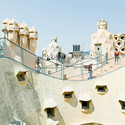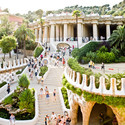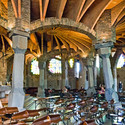
When Catalan architect Antoni Gaudí (25 June 1852 – 10 June 1926) graduated from the Barcelona Architecture School in 1878, the director of the school Elies Rogent reportedly declared: "Gentlemen, we are here today either in the presence of a genius or a madman!" [1] Well over a century later, this tension is still evident in Gaudí's work; though he is widely regarded as a genius architect, his distinctive style stands as a singularity in architectural history—simultaneously awe-inspiring and bizarre, never fitting into any stylistic movement, and never adapted or emulated, except by those still working to complete his magnum opus, Barcelona's famous Sagrada Família.

Born in the Catalan village of either Riudoms or Reus (the records conflict), from a young age Gaudí was fascinated by nature. Between 1875 and 1878, Gaudí was conscripted for compulsory military service, but due to ill health - which he struggled with all his life—he was able to spend much of his time studying at the Llotja School and the Barcelona Higher School of Architecture.

Guadí's fantastical style was informed by a number of influences, and was very much a result of the context of late 19th century architecture, when the requirement to follow strict historical styles was beginning to fall out of favor. As such, Gaudí was able to take inspiration from Oriental styles, and was heavily influenced by the Revival Gothic architecture of the time, most notably encapsulated in the work of French architect Viollet-le-Duc. However, he believed that Gothic architecture was "imperfect," and began to infuse his work with a variety of motifs drawn from nature.

However, as much as his works of architectural decoration are striking, Gaudí is equally notable for his advanced understanding of structures. Having studied geometry in his youth, Gaudí followed advances in engineering and his work regularly features catenary curves, hyperbolic paraboloids, hyperboloids and helicoids, shapes which he used to create efficient (but more importantly dynamic and organic) structures.

Gaudí gained recognition very early in his career with designs such as the Casa Vicens, and in 1883, aged just 31, he was appointed to the Sagrada Família project. Over the following three decades, the work of Gaudí became almost synonymous with Barcelona, as he changed the face of the city and its surrounding regions with projects such as the Parc Güell, Colònia Güell and Casa Milà.

However, in 1915 Gaudí ceased all other projects in order to focus exclusively on the Sagrada Família. He worked on the building for the next 11 years, until he was hit by a tram and died in 1926.
See all the works of Antoni Gaudí featured on ArchDaily via the thumbnails below, and further coverage below those:
Video: What the Sagrada Familia Will Look Like in 2026
Video: The Six Towers that will Crown the Sagrada Família
Gaudí's Sagrada Família to Become Tallest Church in Europe by 2026
Trouble Hits the Final Stages of Gaudí's La Sagrada Familia
8 Architects Whose Names Became Architectural Styles
Never Built New York: Projects From Gaudí, Gehry and Wright that Didn't Make it in Manhattan
Chile to (Finally) Build Gaudí's Only Project Outside of Spain
Gaudí's First-Ever House to Open as a Museum Following Major Restoration
References:
- Jeremy Roe, "Antoni Gaudí" (Parkstone International, 2012) p.18










